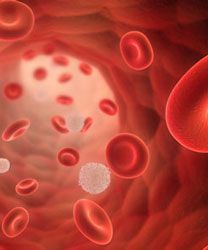Article
Expert Highlights Advances for Patients With PNH
Author(s):
Mohamed Kharfan-Dabaja, MD, discusses the future of PNH treatment, the various symptoms that can present in PNH, and the challenges that still remain for further improving outcomes.
multiple myeloma

According to Mohamed Kharfan-Dabaja, MD, there is ever-increasing hope for patients suffering from paroxysmal nocturnal hemoglobinuria (PNH), a rare disease characterized by the premature breakdown of blood cells that is caused by a somatic mutation in the PIGA gene.
One such development, eculizumab (Soliris), has emerged as a game-changing antibody in the treatment of PNH. As seen in various follow-up studies of this agent, says Kharfan-Dabaja, the life-expectancy of patients with PNH has increased. Nevertheless, further development of agents that can improve patient outcomes continues to occur.
OncLive: Can you provide an overview of your talk on PNH?
What are some of the disease characteristics at presentation?
Because it's so rare, do we know what some of the causes are for this disease?
What are the biggest remaining challenges about this disease?
In an interview during the 2017 OncLive® State of the Science SummitTM on Hematologic Malignancies, Kharfan-Dabaja, professor of oncological sciences at Moffitt Cancer Center, talked about the future of PNH treatment, the various symptoms that can present in PNH, and the challenges that still remain for further improving outcomes.Kharfan-Dabaja: Paroxysmal nocturnal hemoglobinuria is an exceedingly rare disease. What is important to keep in mind is that in the past, when no effective therapies were available, one would expect that one-third of the patients were not going to make it past 5 years. Nowadays, there has been recent development of very effective therapies, namely eculizumab, which is a humanized monoclonal antibody that targets the terminal complement of C5. That certainly has made a very positive impact in terms of altering the natural history of the disease. Now…many peer-reviewed manuscripts and [other] research [has] shown that the life expectancy of these patients is very close, if perhaps even similar, to what we expect from the normal population.Patients can sometimes present with hemolysis or signs of bone marrow failure. In other cases, they can present with thrombosis. One of the unique features of this disease is that it tends to present with thrombosis at a very unusual site, but not very often. One is called the Budd-Chiari syndrome. It can also present with mesenteric vessel thrombosis, which are not unique for the disease, but perhaps one has to think about this disease. It is an acquired disease. It is a somatic mutation of the PIGA gene. There is not a well-known cause-effect agent that you can say, "That can cause PNH." It happens, and it doesn't seem to have a particular age. It can happen at any age, basically.Obviously, this has been a great step forward. Certainly, these emerging therapies have been able to improve the outcome of these patients.
What ongoing clinical trials in this space are you excited about?
What should community oncologists take away from your lecture and apply to clinical practice?
The challenge is the availability of this drug all throughout the world. In my opinion, this disease continues to be underdiagnosed, and it's something one has to keep in mind considering how rare the presentation is. The next challenge is, how we can make this drug available to the underdeveloped world where they don't have access to this drug. There are certain clinical trials to try to see the long-term positive impact that this drug has brought on patient with PNH. The progress has been tremendous and they certainly continue to build on that.The most important message is to think about the disease. It's not something you see every day in your practice. Think about the rare presentation. Think about those cases where they present with more than 1 clinical symptom at the same time when you are trying to solve the puzzle. If this patient has hemolysis and thrombosis, how do you starting thinking along the lines that this patient could have PNH? They have to be aware that this disease is there, and that it is underdiagnosed.
Many times, these patients are treated for…thrombosis in the setting of Coombs-negative disease where those patients need to be considered for PNH as 1 of the main diseases in the differential diagnosis.












%20(2)%201-Recovered-Recovered-Recovered-Recovered-Recovered-Recovered-Recovered-Recovered-Recovered-Recovered-Recovered-Recovered-Recovered-Recovered-Recovered-Recovered-Recovered.jpg?fit=crop&auto=format)
%20(2)%201-Recovered-Recovered-Recovered-Recovered-Recovered-Recovered-Recovered-Recovered-Recovered-Recovered-Recovered-Recovered-Recovered-Recovered-Recovered-Recovered-Recovered.jpg?fit=crop&auto=format)
